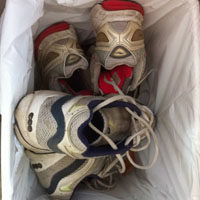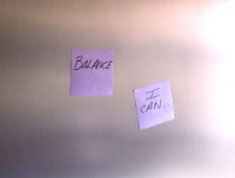 Good form is important to remember when working out. When performing any exercise, you want to make sure that your form is correct and your movements are controlled. Learning how to properly hold yourself helps to make your workouts more effective, and maybe more importantly for others, it helps to keep you from being all willy-nilly looking while exercising.
Good form is important to remember when working out. When performing any exercise, you want to make sure that your form is correct and your movements are controlled. Learning how to properly hold yourself helps to make your workouts more effective, and maybe more importantly for others, it helps to keep you from being all willy-nilly looking while exercising.
Proper form is maintained by doing this: slightly contract your shoulder blades together while making sure your shoulders aren’t hanging out by your ears. (In personal trainer speak, your shoulders are retracted and depressed.) Loosen the muscles in your neck and make sure you’re not straining your shoulders forward, thus caving in on your chest. This helps to tighten your upper body so when you perform an exercise, you will be able to maintain balance and control, thus preventing a possible injury or fall.
Now while you’re standing tall, pressing your shoulders down and back, you also want to remember your core. I’m sure you’ve heard that you should pull your bellybutton, or naval, into your spine. That is correct, but you don’t want to keep it there, sucked in and glued to your spine so that your mid-section is hollowed out. That’s where many people get stuck and this position can constrict breathing patterns causing you to not get as much oxygen as your body needs, leading to fatigue. This is where breathing comes into play.
The best way I’ve learned to explain breathing is to tell my clients to exhale when they are performing a move that goes against gravity. Let’s say you’re performing a bicep curl, you will exhale when you are bringing the weight up to your shoulder, and then inhale when you are lowering the weight back down. Or if you’re performing a forward lunge, when you step your foot forward and lower yourself, you inhale, and then as you push through the front leg back to standing position, you exhale.
Now… if I may push my luck and assume you’re still reading this, let me add one more thing. On the inhale, I want you to be able to take a nice, deep, belly breath. That means you’re letting go of pulling in your bellybutton and you’re letting it all hang out! That’s right, pop that belly right out there and let it fill up with some sweet air. Then on the exhale, pull that belly right back in, slowly and controlled, and pull it into the spine—while maintaing neutral spine, meaning keeping that little curve in your low back in tact.
Does this make sense? Basically you’re not holding your breath, you’re not keeping your belly sucked in and you’re not herniating any discs! You’re breathing in nice and deep, and then exhaling nice and strong, contracting the abs.
This is going to take some practice but as with everything, practice makes perfect so even when you’re sitting at your desk, on the train or hanging at the playground, practice perfecting the belly breath. Breathmasters can guide you to breathing properly so make sure to check their website out.
Oh, and there is one more thing… the count.
When you inhale, drag it out to a count of 4. On the exhale, speed it up to a count of 2. Exhaling usually allows for a quicker, faster move while inhaling allows for you to draw the motion out. For example, back to the bicep curl, when you’re lifting the weight, you would exhale to a count of 2. Then when you’re lowering the weight, draw it out to a count of 4. This way you’re working your muscles both concentrically and eccentrically. (I totally just geeked out there and went so far as to use technical terms. I must apologize…) When you draw out the breath to a count of 4, you’re working the opposing muscles so you’re getting a better workout and will probably fatigue the muscle faster depending on the amount of poundage you’re lifting and the number of reps.
And there you have it. Proper form, proper breathing and how the two work together. Don’t be scared or intimidated by it, just learn to practice it because as women, we’ve been somehow programmed to walk around with our bellies sucked in so much so that a vast majority of us, myself included, are chest breathers. And what that means is that we only breath in until our chests are full, we don’t dig deeper and loosen our bellies so we can breathe in more air, get more oxygen and better supply our bodies with better blood flow. So don’t be a chest breather. Let loose and be a belly breathing fool!
Have you noticed the way you breath in? Are you a chest or belly breather?






